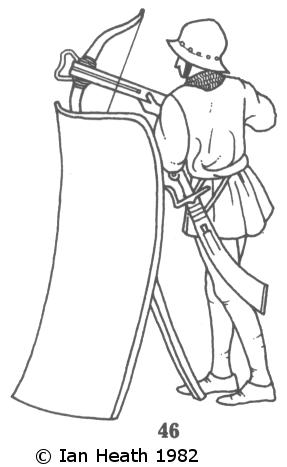
Create an Amazon Wedding Registry
CROSSBOWMAN WITH PAVISE, 15th CENTURY
An extract from Armies of the Middle Ages, Volume 1by Ian Heath



46. CROSSBOWMAN WITH PAVISE, 15th CENTURY
Taken from a silverpoint drawing in John Rous’ ‘Pageant’ of c. 1485, this figure allegedly depicts a French crossbowman engaged in the defence of Caen in 1417. It is principally of interest in showing a pavise in use. This was a larger variant of the shield-type already referred to under figure 40. It was much used by crossbowmen in particular, and to a lesser extent by archers, from the 14th century to the early-16th, though generally only in siege-work (but see next note). Where too cumbersome for the bowman to wield himself, but still light enough to manoeuvre, such shields were often held by a second man.
The pavise’s name, usually rendered in contemporary sources in its French form of pavais or pavache, derives from its place of origin, Pavia, whence this type of shield seems to have originated late in the 13th century. It should be noted, however, that in 14th and 15th century sources the word had the rather more general meaning of any type of large and usually near-rectangular shield; the shield of 40, as we have already seen, is a pavais for example, as too is that of figure 48. Modern authorities therefore often use the word mantlet instead when describing shields of the type shown here.